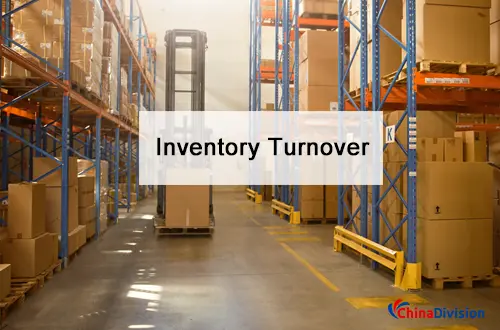Why is Inventory Turnover Important and How to Improve It?
Inventory turnover, a seemingly boring financial indicator, is actually the lifeblood of cash flow and invisible killer of profits for cross-border e-commerce and B2B companies. Whether it is a B2B company or an e-commerce seller, efficient inventory management is one of the key factors for success.
Table of Contents
- What is inventory turnover?
- Why is inventory turnover rate important?
- What is average inventory turnover rate?
- High inventory turnover rate VS low inventory turnover rate
- How to improve inventory turnover rate?
- In-depth question answering: Concerns of B2B and e-commerce sellers
- How can ChinaDivision help you optimize inventory turnover?
Have you ever stared at a pile of unsalable inventory late at night, calculating the monthly storage costs with fear? Have you missed the opportunity to sell a hit product because your funds are "locked" by inventory?
As an international warehousing and fulfillment service provider, Chinadivision is well aware of the importance of inventory turnover (also known as stock turnover) to corporate operational efficiency and cost control. Today, let's take a deep look at this core indicator and answer some of your most concerned questions.
What is inventory turnover?
Inventory turnover refers to the number of times inventory is sold and replaced within a certain period (usually one year). It directly reflects the efficiency of an enterprise's inventory management and is an important indicator of the health of the supply chain. A high inventory turnover rate means that products are selling well and funds are recovered quickly, while a low turnover rate may indicate problems such as inventory backlog, excessive capital occupation, or inaccurate market demand forecasts.

Inventory turnover rate calculation formula:
Inventory turnover rate = annual sales cost / annual average inventory value
Why is inventory turnover rate important?
Cash flow optimization: High inventory turnover rate means that products can be sold quickly, thereby reducing the funds tied up in unsold inventory and freeing up capital for new opportunities.
Storage efficiency: Higher turnover rate can reduce the space occupied by slow-moving or obsolete goods, thereby minimizing warehousing costs.
Market responsiveness: Efficient turnover ensures that your catalog is aligned with consumer demand, thereby reducing the risk of excess inventory or out-of-stock.
What is average inventory turnover rate?
Average inventory turnover rate is calculated by dividing the cost of sales in a specific time period by the average inventory during that period. This number can help companies compare themselves with the industry average and identify room for improvement. The ideal turnover rate varies from industry to industry. For example, the fast-moving consumer goods industry may pursue higher turnover, while luxury goods or customized products are relatively low.
High inventory turnover rate VS low inventory turnover rate
High inventory turnover rate (High Stock Turnover) sounds like a good thing, which means that goods are circulated quickly, capital utilization is high, storage costs are efficiently diluted, and risk resistance is strong. However, too high turnover may also mean insufficient inventory, missed sales opportunities, and even affect customer satisfaction. Therefore, it is crucial to find a balance point that suits your own business.
Low turnover rate (Low Stock Turnover) is a dangerous alarm! Funds are "frozen" in the warehouse, high storage fees and insurance premiums continue to eat up profits, and the risk of goods becoming obsolete and damaged increases sharply, and may even drag down cash flow.
The impact of inventory turnover rate: positive and negative
Positive impact: High turnover rate can reduce storage costs, reduce the risk of expired or obsolete goods, improve cash flow, and enhance corporate competitiveness.
Negative impact: Low turnover rate will cause funds to be occupied for a long time, increase storage costs, and even face the risk of inventory depreciation due to changes in market demand.
How to improve inventory turnover rate?
Accurately predict demand: Use data analysis tools, combined with historical sales data and market trends, to more accurately predict demand and avoid excessive inventory.
Optimize supply chain management: Establish close cooperation with suppliers, shorten replenishment cycle, and adopt JIT (Just in Time) inventory management system.
Promotion strategy: Regularly clean up inventory and accelerate the sales of slow-moving goods through discounts, bundling sales, etc.
Diversified sales channels: Expand online and offline sales channels, increase product exposure, and promote sales.
Fast fulfillment and partitioned storage: Through the fulfillment centers and partitioned storage mechanisms established globally, orders can be "shipped nearby", the processing cycle can be shortened, and the inventory flow speed can be optimized.
Automated order processing: ChinaDivision provides automated fulfillment tools, which can automatically package, ship, and synchronize inventory once an order is generated to avoid human delays.
Customized replenishment warning: Set dynamic thresholds. Once the inventory of a certain product is about to fall below the safety line, the system will automatically issue a replenishment reminder to ensure that best-selling products are not out of stock.
In-depth question answering: Concerns of B2B and e-commerce sellers
What should I do if the inventory turnover rate is far lower than the industry average?
First, conduct a comprehensive inventory audit to identify slow-moving products. Then, adjust the procurement strategy to reduce the purchase volume of these products, while increasing promotion efforts. With our warehouse management system, you can monitor inventory dynamics in real time and adjust strategies in time.
How to ensure that there is no shortage of goods under high turnover?
Implement an advanced inventory warning system to perceive changes in inventory demand in advance. We provide flexible warehousing solutions that can respond quickly to market changes and ensure the continuity and stability of the supply chain.
For seasonal products, how to manage inventory turnover?
For seasonal products, it is recommended to adopt batch procurement and pre-sale models, combined with historical sales data, to accurately plan the inventory volume for each season. With our global warehousing network, you can achieve nearby warehousing, respond quickly to market demand, and reduce transportation time and costs.
How can ChinaDivision help you optimize inventory turnover?
Optimized inventory turnover (Turnover of Stock) is the core competitiveness. Chinadivision is not only a warehouse, but also the intelligent engine of your supply chain:
Data-driven decision-making: Provide clear turnover reports and in-depth analysis to indicate the direction of optimization.
Networked intelligent fulfillment: Global warehouses are close to buyers, shortening delivery time and accelerating payment collection.
Ultimate cost control: Through inventory optimization, long-term storage fees, capital occupation costs, and cargo damage risks are directly reduced.
Flexible expansion: When the business grows or adjusts, warehousing resources seamlessly match your turnover needs.
Efficient inventory turnover is the key to releasing cash flow and improving profitability. Whether you are confused about how to calculate inventory turnover, anxious about the impact of high and low inventory turnover, or struggling to find an effective strategy to improve inventory turnover, Chinadivision's intelligent warehousing and fulfillment solutions can provide you with professional support that goes straight to the pain point.
Contact Chinadivision's warehousing and logistics experts now to get exclusive inventory turnover diagnosis reports and optimization solutions! Let your goods flow efficiently and make huge profits. We provide one-stop international warehousing and fulfillment services, from inventory management, order processing to logistics distribution, to help you optimize inventory turnover and improve business efficiency. Whether you are a B2B enterprise or an e-commerce seller, choosing Chinadivision means choosing an efficient, flexible and professional inventory solution.





